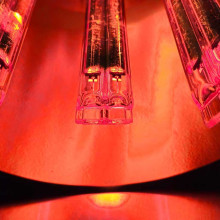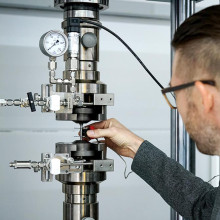IR and UV emitters for high-quality car interiors
- Details
- Hits: 315
Should be comfortable and user-friendly Interior Parts for the Vehicle-Be interior. For such applications Excelita's Noblelight the right technology: In automobile production, an astonishing number of manufacturing steps for seats, dashboards, handles, switches, carpets and shelves are carried out with the help of Infrared-Heat and UV emitters carried out efficiently.

Contents
- IR and UV emitters in automobile production
- Conceal and remove wrinkles with IR radiation
- Infrared and UV heat optimize drying and curing
- Contour-adapted deburring and shaping
IR and UV emitters in automobile production
 Infrared radiation systems and UV light technologies take on the following functions in production and Refining of automotive components:
Infrared radiation systems and UV light technologies take on the following functions in production and Refining of automotive components:
- Infrared radiation is used in many processing steps such as shaping, deburring, laminating, drying or activating coatings and adhesives. Precisely adapted infrared systems improve quality while saving energy.
- UV light On the other hand, it cures UV (ultraviolet) paints and coatings for handles, switches or panel components. Here, printing inks or UV coatings are applied and then cured with UV light. The result is scratch-resistant, durable components.
While many of the steps involved in producing and refining car interiors are complex and require energy, drivers want to receive good quality at a reasonable price.
So optimize modern UV and infrared radiation industrial manufacturing steps:
- save energy
- Increase production rate
- improve quality
- Ensuring sustainability.
Conceal and remove wrinkles with IR radiation
Infrared emitters ensure that Car Seat Covers no wrinkles and car carpets fit perfectly. The infrared systems accelerate adhesive drying in vacuum presses for covering such components with leather, fabric or Plastic.
Plastic carrier parts with PVC or TPO films vacuum laminated benefit from fast medium-wave infrared emitters because their fast response times allow precise control.
Infrared emitters also connect carrier fabrics and leather surfaces of roof interior linings. This gives them one perfect fit and extend their lifespan.
Intier Automotive Interiors: Door panel
Intier Automotive Interiors from Great Britain, Car interior parts manufacturer such as door panels, uses an innovative method for its production. A cut piece of fabric is placed into a mold, which is then filled with hot polypropylene. To prevent wrinkles from forming during the filling and cooling process, the fabric is treated with short-wave infrared emitters. This technique makes it possible to effectively remove wrinkles without damaging the material.
This application of infrared radiation offers significant advantages over traditional methods, as it is non-contact and gentle on materials Smoothing of surfaces enabled. The short-wave infrared emitters react quickly, which is particularly useful for switching off the emitters immediately if the conveyor belt unexpectedly stops. In addition, the radiation can be adjusted so that individual temperature profiles can be created for different fabric types and colors.
Features at a glance
- shortwave Spotlights with fast response times
- contact-free and gentle heat treatment
Technical data
- eight short-wave infrared emitters each 6 kW
- Control for five different heat profiles
Bentley: roof lining
Specially adapted infrared systems were developed for the roof interior panels of the Bentley Continental 4- and 2-door models in order to, on the one hand, Optimize fit and on the other hand to extend the service life. The cladding consists of a carrier fabric, an adhesive and a leather surface that are intended to remain permanently bonded together.
With the introduction of a new one adhesive, which significantly increased bond strength, a suitable heat source had to be found that could reach the required activation temperature of 65 °C without affecting the cycle time.
Initial tests with a convection oven showed problems due to material movement between the fabric and the leather. Bentley then collaborated JSK Ultrasonics together to develop a special system that uses infrared emitters from Noblelight.
In the current application, the carrier fabric is first sprayed with adhesive and then precisely fixed together with the leather lining in a vacuum press at a vacuum of 7inHg. The infrared system is positioned above it and the protective film on the press is heated to 85 °C. Despite heat loss through the film, the adhesive achieves this Target temperature of 65 °C within a precisely controlled time of approximately 3 minutes as soon as the heating frame is removed and the vacuum is released.
Two different infrared systems were implemented: one for the 4-door model with fifteen 5 kW medium wave emitters and another for the 2-door model with a total output of 108 kW, consisting of two units of 54 kW each.
Features at a glance
- Infrared emitter from Heraeus connection Carrier fabric and leather surface of roof interior lining
- Glue activation through infrared heat
Technical data
- Activation temperature of 65 ° C
- fifteen 5 kW fast medium wave spotlights for 4-door cars
- 108 kW Infrared system for 2-door cars
- 3 min Heating time
- PID Control
Infrared and UV heat optimize drying and curing
 The use of infrared and UV technologies in the Surface treatment of automotive components offers extensive possibilities, especially when it comes to drying and curing. Plastic parts can first be hardened using UV technology and then effectively dried using infrared technology. This duality of techniques increases the efficiency and reliability of the processing processes.
The use of infrared and UV technologies in the Surface treatment of automotive components offers extensive possibilities, especially when it comes to drying and curing. Plastic parts can first be hardened using UV technology and then effectively dried using infrared technology. This duality of techniques increases the efficiency and reliability of the processing processes.
An innovative approach is to use infrared heat in combination with UV varnishes, which not only increases the energy efficiency of paint curing, but also enables improved crosslinking of the UV paint through preheating. Excelitas Noblelight specializes in application-optimized UV lamps and UV LED systems as well as infrared heat solutions that were specifically developed for efficient paint curing processes. Practical application examples illustrate the advantages of combining UV and IR technologies in automotive production.
Contour-adapted deburring and shaping
Infrared emitters play a central role in the Automation of deburring processes. Specially adapted emitters melt burrs precisely and reproducibly within a few seconds. Thanks to the contour-adapted quartz glass emitters, the infrared heat can be used exactly where it is needed, which significantly increases the quality of the deburring process. Non-contact heating using infrared technology makes it possible to thermoplastics to heat quickly and efficiently, minimizing the reject rate.
The infrared heat also makes it easier to shape and precisely adjust carpet cuts in the car interior. The ability to individually control and regulate individual zones within the infrared system not only optimizes the quality of the end products, but also contributes to Energy saving at.
You might also be interested in...

Infrared heater for efficient heat processes in industry

Material testing | non-destructive and destructive

Dr. Marie-Luise Bopp is Head of Marketing at Excelitas Noblelight GmbH in Hanau.

